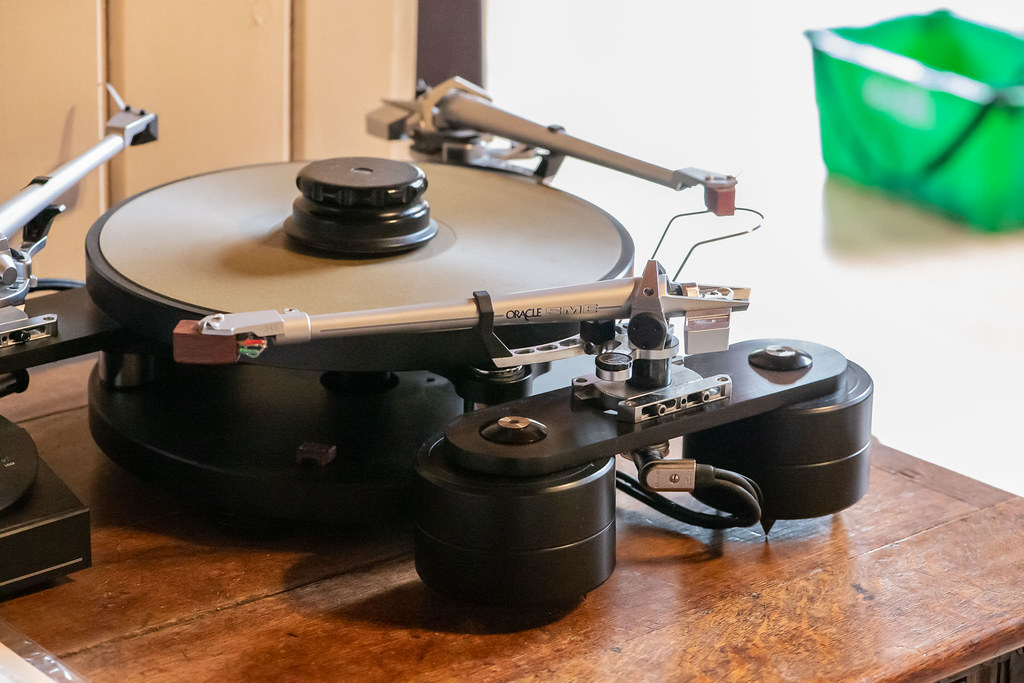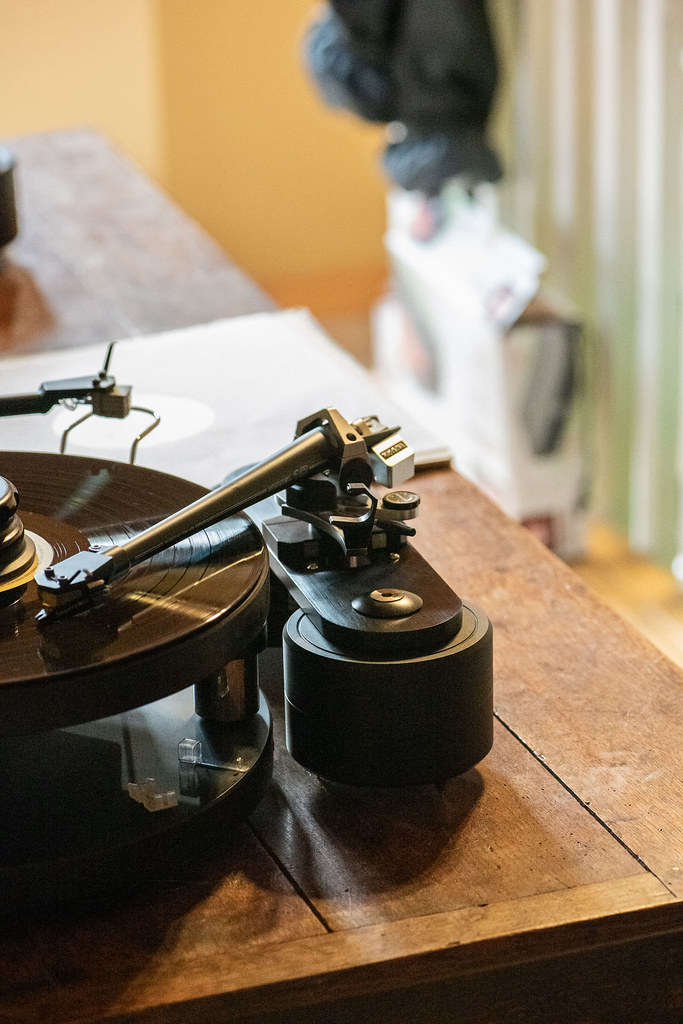Well, the 18th century oak chest wins over all other considerations! It's worth more than all my hi-fi and records.
Vibration Question
Warning to the sensitive: involves tonearm pods.
I know this topic is beyond the pale to some, but my tables cannot take a second tonearm (once upon a time, though, they did), and I enjoy variety in cartridges. I have bought four pods so far from Lee Drage at Acoustand, two plain and two with built in micrometer VTA adjustment. But I discover the airspace around the tables is too congested with six arms, as well as introducing some grounding issues. So, as I told pindac the other day, I started to experiment with using two pods per tonearm. Not just a simple 'if one is good then two must be better' but for practical reasons. Firstly, a pod resting on three spikes weighs about 10lb, but it doesn't take much pressure on the distal end of the arm panel to cause it to tip. One can spoil a carefully set up alignment that way, and if it continues tipping a disaster could happen. So, I thought, why not place a pod under the distal end of the tonearm panel, and prevent that happening?

But then a second thought came along: if the second pod were firmly coupled to the panel, I would double mass and damp vibrations even more. That's a bit theoretical to me, as my oak chest weighs ~350lb and I can stamp on the floor next to it and not disturb a playing stylus. But rigidity is rigidity. So I asked Lee if he could make me a double ended panel with an SME mount centred in the middle. Roughly, like this:

He agreed, and pointed out I would have to forego the VTA adjustment, unless one were to place a screw at each end! I can use the SME mount itself to adjust VTA. though, so that's OK.
Here, finally is the question: he thinks I am simply introducing twice as many vibrations (external, I think he means) into the tonearm by having it rest in two sites on the oak chest, and that I would be better off having one end of the tonearm panel free-floating. My view is that rigidity is paramount, and if a built-in tonearm on a table is firmly coupled to the table then I am moving a bit closer to that ideal by having a firmly coupled chest-table-pod system. What say you?
Showing 10 responses by dogberry
I see the dominant opinion is, as expected: don't use pods at all. But given the turntables I have (where there is no other choice), I shall ask once more, is a tonearm better off on a single pod, or a double pod? The latter doubles the mass coupled to the tonearm, but possibly provides two routes for vibration to be transmitted to the tonearm instead of one. I'm doing it anyway, so don't feel you have to advise me carefully in that respect. I just want to get a feel for whether you think there is any merit in the argument that more external vibrations will be transmitted, and if so, they will outweigh (!) the doubled mass? I expect there isn't much of a body of knowledge on this, but I'm curious as to your thoughts. |
@lewm @mijostyn Thank you, gentlemen, for your (expected) answers. But, the question? One pod better than two, or vice versa? @danmar123 Certainly, but it is the same thing as an Acoustand with built-in mount. I like an Englishman with a lathe, and you seem to have found me another. Maybe it was the way my father spent his evenings in his workshop, or maybe it was Neville Shute. |
@pindac Now don't go giving me ideas! |
Done. The pods holding the Grado are silent, as are those holding the Soundsmith. However, if I tap very hard (like percussing a chest, which I suppose I am, in a way) with two fingers I can hear something with the volume turned up to Quad-destruction levels in the case of the Soundsmith only. Maybe that is why the Soundsmith has discovered it has bass? Anyway, it is good enough for me. I hear nothing at all with the cartridges mounted on the factory and custom mounts, even when I do the hard tap with two straight fingers. |
The chest is old and crudely made, with a very thick top, and seasoned since sometime in the 1600s. But undoubtedly, you are right, @pindac, there must be effects of percussing a drum-like surface like the top of it. Given that the top of the chest must vibrate somewhat on being struck, how can there be little or no sound revealed by the cartridge? I assume the fact the pods are sitting on spikes is helping decouple them from the surface - a mechanical isolator rather than one resulting from material science. But I suppose the practical question is whether my ear can hear the resulting vibrations as transmitted to the cartridge, and I’ll be the first to admit my hearing is compromised, having one ear with about 50% sensitivity in it, and the other totally dead. So if I can hear nothing through the cartridges mounted on the built-in mounts on the percussion test, and nothing through the Grado on the pods, I can say that it works as well as I need it to do. The Soundsmith though does give a faint noise in the speakers, presumably because its cantilever and iron is lighter than that of the Grado (I’m making that assumption because it is a low-output MI, and the Grado is not. Probably most of the reduction in output comes from fewer turns in the fixed coils, but that alone offers no advantage over a high output MI: Peter Ledermann must be using lighter iron on the cantilever as well to make his "MIMC" cartridges because that is what makes them sound different). But this is with the pre-amp turned all the way up, and I would typically play an LP with the volume set to 15-20% of maximum. At that level I can strike the chest and hear nothing. Even so, I think you are right, and not just on theoretical grounds, because the Soundsmith sounds different to the way it sounded on the built-in mount. The Soundsmith initially was a disappointment to me when I bought it as a candidate to replace the Decca. It was so neutral and uncoloured (qualities that actually make it a very good cartridge) it did not get my feet tapping. I found I could improve my response to it with various resistive loadings—lots available on the NuVista Vinyl—and then discovered it sounded equally pleasing via the SUT. But it is a different beast on the bipod; there is more bass and this must be related to the new mount, and that must imply some vibration feeding back into the cartridge. Anathema to some, but I like it! If I am 'making a virtue of necessity' as the old phrase had it, so be it. Thank you for your detailed response, as always. |




 A few pages back I outlined my plans for some experimental double tonearm pods. The panels arrived from Acoustand today and it all seems to work. Very heavy and solid, so should be stable.
A few pages back I outlined my plans for some experimental double tonearm pods. The panels arrived from Acoustand today and it all seems to work. Very heavy and solid, so should be stable.![[IMG]](https://live.staticflickr.com/65535/53647641058_440121052e_b.jpg)